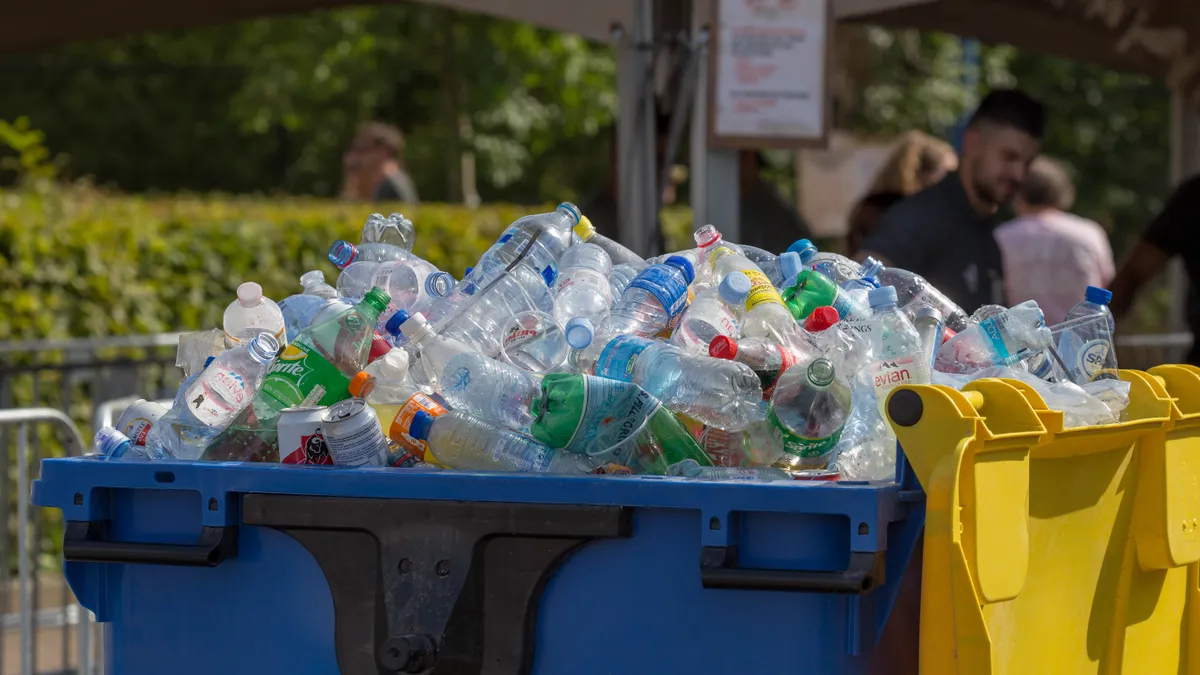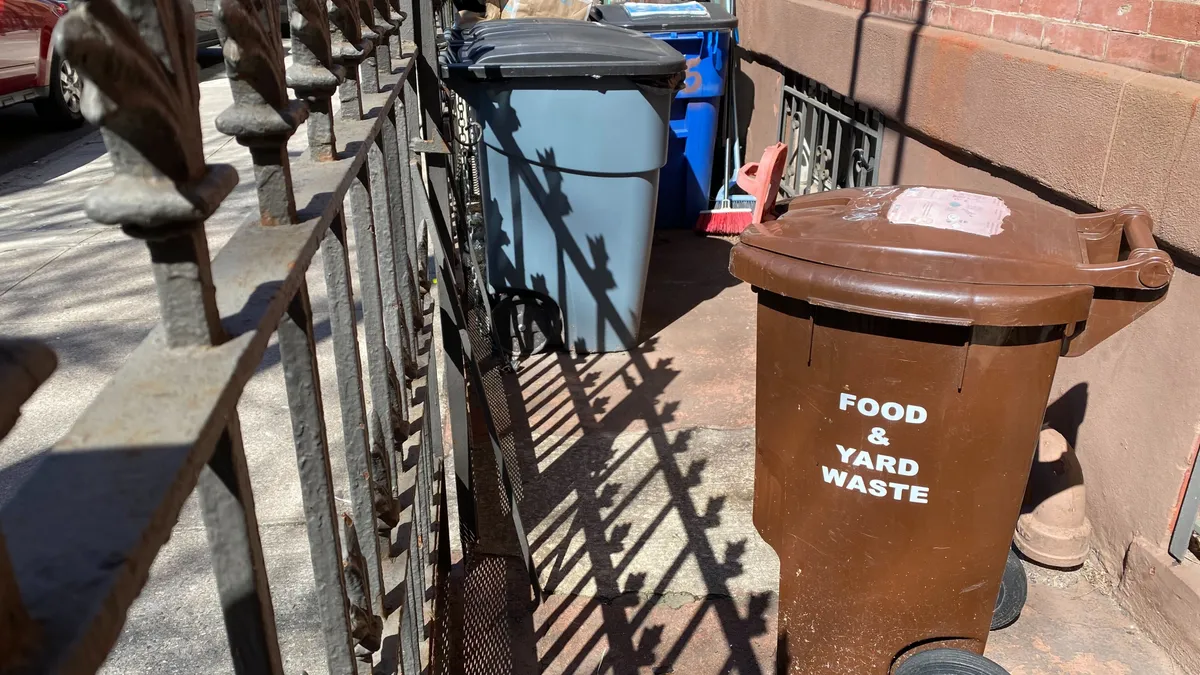Recycled PET was already set to have a tough 2020 as more virgin resin came on the market at incredibly cheap prices, threatening the viability of recycled materials. And then came the pandemic.
Now, slowed collection and processing of coveted food-grade plastics could cut back on the amount of the resin in the recycling system. And when life becomes more normal again, the market could flood with pent-up recycled PET.
Experts seem skeptical that consumer brands will abandon their commitments to increasing the amount of recycled plastic in their products. But the appeal of cheap virgin resin is expected to persist, especially as crude oil hits record-low prices. Market shifts could cut how much a MRF earns off the recycled resin, a consequence that could filter down to how much residents are charged for collection services, according to Darwin Baas, director of Kent County, Michigan's Department of Public Works. “That’s where the rubber is going to hit the road," he told Waste Dive.
The Kent County MRF operates in one of 10 states that offer deposit returns. Bottle manufacturers love the PET containers collected in these states, said Todd Bukowski, a consultant with Packaging & Technology Integrated Solutions, which helps design packaging plans for food and pharmaceutical producers. “Bottle to bottle” programs ensure that companies receive materials that haven’t mingled with other PET packages, like cleaning supplies, he said.
Returning bottles keeps recycling rates high in these states. However, the return locations are often in grocery stores, which are facing heightened sanitation concerns. Relieving these already-stressed facilities of extra responsibilities might explain why nine of the 10 states have temporarily adjusted their bottle deposit requirements. Some, like Michigan, have deemed bottle deposit programs non-critical infrastructure. Others have just changed their approach, such as Oregon’s decision to only operate freestanding drop-off locations.
Residents accustomed to getting a dime or nickel back for every bottle might sit on those packages until they can return them. Even in Oregon, the amount of circulating recycled materials has dropped, said Jules Bailey, chief stewardship officer at the Oregon Beverage Recycling Cooperative, which facilitates the bottle deposits.
The program has seen an exponential rise in “green bag” participation, where residents leave packages of bottles at designated drop-off sites for someone else to sort later. Almost 50% more of these bags get sorted per day compared to pre-pandemic levels. Still, many are depositing at freestanding BottleDrop facilities, where some machines were turned off to enforce social distancing. The program is restoring machine service with physical barriers between each location.
“We’re down in material overall in the system, but it’s not as dramatic as it could be,” Bailey said.
The seemingly indefinite pause on bottle returns might be starting to worry producers. The National Association of PET Container Resources recently published a joint letter with aluminum and glass industry representatives asking that bottle deposit programs be considered essential services and others are raising concerns too.
Market factors
Growing domestic stockpiles include the very PET that manufacturers are eager to have back in circulation, said Sarah Schneider, senior pricing reporter at S&P Global Platts who focuses on petrochemicals. Without bottle drop programs to source recycled PET from, she said, “people have to turn to what’s left of curbside [collection]."
Anecdotally, some residents appear to have tired of stockpiling their containers and chucked them in curbside recycling bins. Since reopening, the Kent County MRF has seen two-and-a-half times more redeemable materials come through, Baas said.
But like the Kent County MRF, some other recycling facilities around the country have closed – sometimes for much longer than a few weeks. Many also process incoming materials slower than before to keep workers six feet apart on certain lines. Some might even have less material to work with overall if smaller municipalities decided to temporarily suspend curbside collection or divert material to disposal. Meanwhile, backyard or garage PET piles are growing. With everyone eating at home, Baas has heard from colleagues in the grocery industry that sales of bottle deposit containers are up 300%.
The gap these missing containers leave in the recycled PET supply chain could be filled by other PET materials. Steve Alexander, president of the Association of Plastic Recyclers (APR), said that while PET levels might have dropped off slightly, other sources of the resin typically bound for sheet or fiber are surging as manufacturing of those products has slowed.
“I don’t know about you, but there’s not a whole lot of people buying carpeting these days,” he said, adding that MRFs may need to do more sorting based on quality standards in the interim.
Some reclaimers might also have to deploy the technology needed to turn these formerly fiber-bound plastics into food-grade resins. Aside from the few facilities that already convert curbside materials into food-grade pellets, according to Schneider, this might be too hard to accomplish long term.
“I think the coronavirus pandemic will definitely have at least some short-term impact mostly on reclaimers at work with this higher quality material," she said.
Manufacturers could be eager to get their containers back as production ramps up for the summer. Generally, hot summers full of outdoor events and activities mean thirsty attendees are drinking out of more PET bottles than usual.
This time of year is typically when producers ramp up for the busy season, said Ben Brooks, the head of plastics recycling price reporting with S&P Global Platts. Depending on how long the pandemic lasts, canceled or postponed events might severely dent demand, he said. Still, all this uncertainty doesn’t mean manufacturers will back off their recycled resin commitments.
“Buyers in the market still have in the back of their minds this looming legislation that is coming up on minimum recycled content that they will have to meet,” Brooks said. Besides, as consumers increasingly associate plastic pollution with particular brands, public goals about increasing post-consumer resin (PCR) content in PET bottles has become a marketing device, added S&P Global Platts petrochemical analyst Rob Stier.
Instead, those companies might struggle to source recycled PET for a little while. That will change once the pandemic is over and growing PET bottle collections finally hit processing centers, a shift Platts and Baas anticipate.
The long view
When deposit programs do start back up again, as is happening in at least one state, they might come through in volumes current processing centers aren’t equipped to handle. Baas said he’s been talking with some grocery retailers that take back high volumes of deposit containers about solutions like temporary drop-off programs that allow the money to be donated to people in need. Otherwise, he said, some people might get sick of their garage stockpiles and forfeit the deposit money.
The sudden boom in recycled PET availability could also put financial pressure on MRFs. Baas has heard post-consumer PET value could drop between 30-60% as recycled volume surges back and bales try to stay competitive with cheap virgin options. As of mid-May, PET beverage bottle and jar prices per pound were about half of what they were a year ago.
Dropping revenue in bale sales may push some MRFs to boost tipping fees, Baas said. While some of that shift could possibly be avoided thanks to increasing value from other products, like fiber, it depends on how long those higher prices last. If tipping fees go up, that change ripples backwards, with haulers then charging municipalities more. For some local governments with tax income cut by the pandemic, the cheaper alternative of disposal might be considered preferable.
Eventually, these month-to-month changes will seem like a blip, according to the Platts predictions. The analysts don’t expect their 10-year future outlook on PET to change. But a lot of smaller MRFs or secondary processors could close if they don’t have the money to handle reduced income for the next year or so.
“These next six to 12 months are going to be heartbreaking for some companies that don't make it,” Stier said. “But we'll get through it and go from there.” The analysts predict closures could result in industry consolidation as larger MRFs try to expand market share or producers like Indorama absorb more of the recycling system.
Of course, some of the short-term PET predictions are also based on factors that change daily. The threat of cheap virgin resin has loomed large, but might not fully come to be as manufacturing plants delay their openings during the pandemic. Analysis has also found that there isn’t enough recycled PET in circulation to meet all US demands for this kind of resin, which could also boost support for further PCR processing and sales.
That need is driven by circularity goals and public company commitments — factors that might unchain recycled resin from typical supply and demand rules, as well as any market predictions based on said rule book, said APR's Alexander: “There’s value in recycled resin that goes far beyond what the price is.”






















